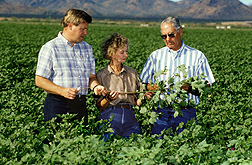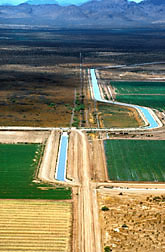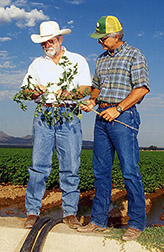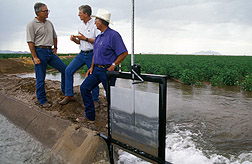Managing Change in Irrigated Agriculture
|
|
A Matter of Understanding, Communication, and Cooperation
Why would I want to work with all the people who are making my life miserable?"
"I'm not being paid to give attention to other agencies' concerns."
"Farmers won't participate."
These comments were typical of those Allen R. Dedrick heard in 1991 when he proposed a collaborative agricultural improvement program to farmers and various state and federal farm service agency representatives in the area served by the Maricopa-Stanfield Irrigation and Drainage District (MSIDD) in central Arizona.
Dedrick, an ARS agricultural engineer in Phoenix, was striving to get people to work together. His goal was to improve agricultural sustainability and natural resource management by improving performance of irrigated agricultural systems in the district.
By the time the MSIDD management improvement program (MIP) came to a formal close 3 years later, the area had undergone what O. L. "Van" Tenney describes as a "cultural change."
As general manager of the MSIDD, Tenney participated in all phases of the program. He is now general manager of the Glenn-Colusa Irrigation District in Willows, California.
|
|
"Old territorialities and animosities fell away unnoticed as people focused on common goals," reflects Tom Burbey. He is with the Arizona Project Office of the U.S. Department of the Interior's Bureau of Reclamation.
Bringing It Off
How did nine federal and state agencies, an irrigation district comprising 87,000 acres, and fanners manage to get together?
"First, everyone needed the same understanding of what was currently going on in irrigated agriculture," says Dedrick, director of the U.S. Water Conservation Laboratory.
"That would provide a level field where all the players could come together to identify opportunities for improvement, do the planning, and then make the changes in a coordinated way."
So the first part of the three-part MIP process was analyzing the current performance of irrigated systems in the area to get a common, shared understanding of the situation. Next came defining opportunities and making plans for necessary change. Last was implementing plans for a coordinated effort to improve irrigation and overall resource management within the district.
Dedrick's reasons for leading a 3-year intensive effort to change the way an area went about the business of agriculture were grounded in ARS' view that delivering technology and making it work are part of a scientist's job.
But the agency has traditionally worked largely on the farm, so external factors affecting technology delivery haven't generally been under researchers' control. Dedrick remembers the frustration when he and others developing on-farm irrigation technology had to stop their efforts at the point where the irrigation water entered the farm.
"We couldn't tell the district how to deliver the water so farmers could be more efficient," says Dedrick. "Being able to provide the appropriate link between farm and district through the MIP was strong motivation."
"And we'd developed a lot of technology that was either still sitting on the shelf or being used improperly," adds ARS hydraulic engineer Albert J. Clemmens, "innovations like new irrigation scheduling methods and ways to measure waterflow." A research leader with the Phoenix lab, he was a member of the team that analyzed the MSIDD performance level and helped in technology transfer.
"The MIP looked like a good vehicle to get new technology—and the expertise to manage it—into users' hands."
|
|
Checking It Out
A group of government agencies that Dedrick brought together in 1990 decided to test the MIP process through a demonstration project.
The group included USDA's ARS and Natural Resources Conservation Service (NRCS), the Bureau of Reclamation, Arizona Departments of Water Resources and of Environmental Quality, and the University of Arizona's Cooperative Extension. Joining later were the Arizona Department of Agriculture and the University of Arizona's College of Agriculture.
Two consultants also worked on the demonstration project: David E. Levine, a management and team-planning specialist in Washington, D.C., and Wayne Clyma, a Colorado State University agricultural engineer in Fort Collins.
Once the project got under way, exclamations of "I didn't know that!" echoed and re-echoed. Agency representatives were surprised to learn that farmers and others often knew little about agency services available to them.
When the analysis was completed, workshops were organized to share findings with both area farmers and support and regulatory organizations.
"Some groups and individuals initially distrusted each other because they didn't know what one another's responsibilities or goals were," says Shirley A. Rish, an ARS program analyst who served as a facilitator and member of the management team.
"But during the workshops, everyone began to build the kind of open communication needed to plan and implement change."
Farmers were major participants in the workshops and throughout the rest of the program because Dedrick's policy was: We don't have a meeting without a farmer in the room.
"It wasn't long before I realized that we, as farmers, were not aware of limitations that agencies had to contend with—and that agency people didn't know everything that farm managers must face," says Gary J. Butler, who farms near Stanfield, Arizona. He was one of 25 who participated in the MIP program.
Butler's observation of agencies' lack of understanding about the farm was confirmed by Gary Sloan, district watermaster.
"We've always tried to deliver water at the lowest cost, but it's hard to help users if you don't know what they do with the product," he says. Now, the district’s overall approach to water delivery is client-oriented.
"The district took steps to become more flexible in meeting farmers' needs," says Eduardo Bautista, another ARS agricultural engineer and team member.
"The increased communication between farmers and the district improved understanding on both sides, resulting in improved water delivery service and fewer farmer complaints."
Mutual Understanding Brings Change
Understanding farm needs led the district to provide lower water rates in the winter, so farmers could grow small grains.
Tenney sent a letter of notification to the farmers that read, "As many of you know, the MIP study recently conducted within the district reported that much of the district has effectively become a cotton monoculture. The report stated that with the absence of crop rotation, cotton yields throughout the district have fallen. The Board of Directors has reduced the winter water rate with the intent of improving the feasibility of planting winter crops in order to help remedy this increasing problem within the district."
As a result, increasing numbers of farmers planted wheat.
In 1994, the accomplishments of the MIP program—and the process itself—were formally evaluated.
"We cannot say that the program saved growers a certain amount of money or reduced water use by a given amount. It was not our goal to collect that information," says Rish. "Rather, the evaluation showed that the MIP succeeded in providing the foundation of understanding and communication needed for people to work together."
Butler talks about one of the results—a farmer-led program in which farmers meet periodically to exchange ideas on their farming practices.
"The grower-to-grower contact is especially beneficial," says Butler. "We share what we know, and we bring in experts who explain the latest technology on plant nutrition and irrigation management, for example. Previously, there had been the misconception that farmers didn't want other farmers on their farms."
According to Ralph Ware, district conservationist from the Casa Grande (Arizona) NRCS field office and member of the team that analyzed performance level, "Before the program, the district and NRCS had almost no contact with each other. Now, the district helps provide new farmers a coordinated source of information that they can use."
Using input from the district, other agencies, and farmers, Ware convenes a joint farmer-interagency group that meets with new farmers.
"We've been successful in getting those who've farmed the land in the past to attend meetings," says Ware. "Their experience has proved invaluable to new growers."
"I like to attend the new grower meetings for my own sake," says Loren Pratt, who farms near Maricopa. "With all the agencies and many other farmers together in one place, it's a great source of information."
Another collaborative effort is town hall-type meetings, one of which resulted in formation of a pest-control district; another provided farmers with accurate, coordinated information during a severe flood.
Dedrick is currently exploring the feasibility of developing a management improvement program to guide a Texas irrigation district in long-term improvement plans.
Some participants in the program suggest that under the right conditions, the model can be used for applications other than irrigated agriculture.
"It's not limited to one industry," says Tenney. "It could be used wherever more coordination is essential for improvement. This might even include urban development planning."
Although the formal MSIDD project ended January 1994, the process is continuing, now guided by a coordinating group headed by Butler.
"Our team only formed the platform for change and improvement. It was the farmers and individual agency participants and their mandators who can lake credit for this success," says Dedrick. -- By Dennis Senft, ARS.
Eduardo Bautista and Albert J. Clemmens, are at the USDA-ARS U.S. Water Conservation Laboratory, 4331 East Broadway Road, Phoenix, AZ, 85040-88070; phone (602) 437-1702, fax (602) 437-5291.
"Managing Change in Irrigated Agriculture" was published in the October 1995 issue of Agricultural Research magazine.










